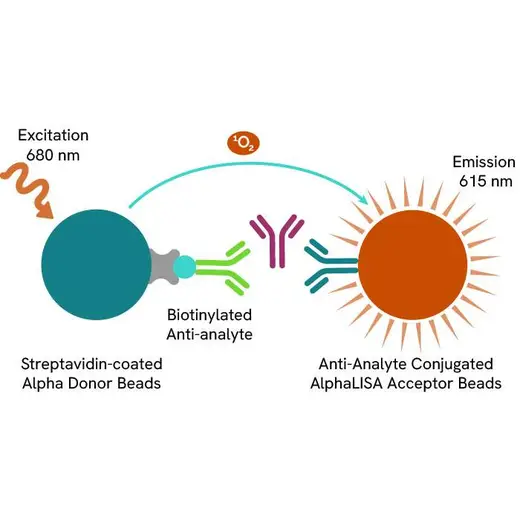
AlphaLISA Mouse Leptin Detection Kit, 5,000 Assay Points


 View All
View All
AlphaLISA Mouse Leptin Detection Kit, 5,000 Assay Points














The AlphaLISA™ Mouse Leptin Detection Kit is designed for detection and quantitation of mouse leptin in serum, buffered solution or cell culture medium in a homogeneous (no-wash steps, no separation steps) assay.
| Feature | Specification |
|---|---|
| Application | Protein Quantification |
| Dynamic Range | 26.5 - 300,000 pg/mL |
| Limit of Detection | 26.5 pg/mL |
| Limit of Quantification | 89.3 pg/mL |
| Sample Volume | 5 µL |
The AlphaLISA™ Mouse Leptin Detection Kit is designed for detection and quantitation of mouse leptin in serum, buffered solution or cell culture medium in a homogeneous (no-wash steps, no separation steps) assay.







AlphaLISA Mouse Leptin Detection Kit, 5,000 Assay Points







AlphaLISA Mouse Leptin Detection Kit, 5,000 Assay Points







Product information
Overview
Formats:
- Our 500 assay point kit allows you to run 500 wells in 96-well or 384-well format, using a 50 µL reaction volume (5 µL of sample).
- Our 5,000 assay point kit allows you to run 5,000 wells in 96-well or 384-well format, using a 50 µL reaction volume (5 µL of sample).
Features:
- No-wash steps, no separation steps
- ELISA alternative technology
- Sensitive detection
- Broad sample compatibility
- Small sample volume
- Results in less than 3 hours
- Half the time of an ELISA assay
In the mouse, leptin is a hormone that contains 146 amino acid residues and is secreted by differentiated adipocytes. It regulates energy homeostasis as a result of its action on the brain via hypothalamic neuronal pathways expressing the leptin receptor (LR). Hereditary deficiency of leptin, or functional LRs, causes severe obesity in humans and mice. Leptin-mediated signaling has been implicated in the regulation of food intake, energy expenditure, lipid and carbohydrate metabolism, and reproductive, neuroendocrine, thyroid, and immune function.
AlphaLISA technology allows the detection of molecules of interest in a no-wash, highly sensitive, quantitative assay. In an AlphaLISA assay, a biotinylated anti-analyte antibody binds to the Streptavidin-coated Donor beads while another anti-analyte antibody is conjugated to AlphaLISA Acceptor beads. In the presence of the analyte, the beads come into close proximity. The excitation of the Donor beads causes the release of singlet oxygen molecules that triggers a cascade of energy transfer in the Acceptor beads, resulting in a sharp peak of light emission at 615 nm.
Specifications
| Application |
Protein Quantification
|
|---|---|
| Automation Compatible |
Yes
|
| Brand |
AlphaLISA
|
| Detection Modality |
Alpha
|
| Dynamic Range |
26.5 - 300,000 pg/mL
|
| Limit of Detection |
26.5 pg/mL
|
| Limit of Quantification |
89.3 pg/mL
|
| Product Group |
Kit
|
| Sample Volume |
5 µL
|
| Shipping Conditions |
Shipped in Blue Ice
|
| Target |
Leptin
|
| Target Class |
Biomarkers
|
| Target Species |
Mouse
|
| Technology |
Alpha
|
| Therapeutic Area |
Metabolic
|
| Unit Size |
5,000 Assay Points
|
Image gallery






AlphaLISA Mouse Leptin Detection Kit, 5,000 Assay Points






AlphaLISA Mouse Leptin Detection Kit, 5,000 Assay Points






Video gallery

AlphaLISA Mouse Leptin Detection Kit, 5,000 Assay Points

AlphaLISA Mouse Leptin Detection Kit, 5,000 Assay Points

Resources
Are you looking for resources, click on the resource type to explore further.


How can we help you?
We are here to answer your questions.






























